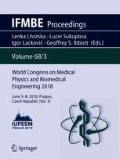Abstract
Objective: To compare a modified single-isocenter technique between (1) 6 MV and 6FFF and (2) fixed collimator angles and adjusted collimator angles for three intracranial lesions by using VMAT-SRS. Materials and methods: Twenty patterns of three intracranial lesions varying in size and location were generated. The VMAT plans using Eclipse version 13.6 were initially generated according to the University of Alabama, Birmingham’s (UAB’s) guidelines. Planning parameters including 6 MV, 6FFF, and collimator angles were further modified. All plans were normalized to achieve a 99% dose coverage with 20 and 24 Gy to 5 mm and 10 mm lesions, respectively. Dosimetric parameters, including CIRTOG, CIPaddick, GI, HI, mean dose to the normal brain, and V5Gy and V12Gy, were analyzed using Wilcoxon or paired t-test. Results: The 6 MV plans with adjusted collimator angle provided better CIRTOG (1.217 vs. 1.266, p = 0.007) and CIPaddick (8.30 vs. 8.13, p = 0.007), while the 6FFF plans were not statistically different. For both energies, the adjusted collimator angles were less than V5Gy (p < 0.01), V12Gy (p < 0.01) and GI (p < 0.001) compared to the fixed collimator angles of UAB protocol, while the HI index was similar. The plans with 6FFF offered superior plan quality than 6 MV for target coverage (CIRTOG 1.222 vs. 1.266, p = 0.005 and CIPaddick 0.832 vs. 0.813, p = 0.002), dose fall off (GI 7.246 vs. 8.264, p < 0.001) and normal brain sparing (V12Gy 3.802 vs. 4.224, p < 0.001 and V5Gy 22.092 vs. 24.966, p < 0.001). Conclusion: The optimization of collimator angles show an improvement in dose fall-off and normal brain sparing relative to the fixed collimator angles. Plans with 6 FFF provide a better plan quality than 6 MV.
Access this chapter
Tax calculation will be finalised at checkout
Purchases are for personal use only
References
Thomas, E.M., et al., Comparison of plan quality and delivery time between volumetric arc therapy (RapidArc) and Gamma Knife radiosurgery for multiple cranial metastases. Neurosurgery, 2014. 75(4): p. 409–17; discussion 417–8.
McDonald, D., et al., Comparison of radiation dose spillage from the Gamma Knife Perfexion with that from volumetric modulated arc radiosurgery during treatment of multiple brain metastases in a single fraction. J Neurosurg, 2014. 121 Suppl: p. 51–9.
Clark, G.M., et al., Plan quality and treatment planning technique for single isocenter cranial radiosurgery with volumetric modulated arc therapy. Pract Radiat Oncol, 2012. 2(4): p. 306–13.
Wu, Q., et al., Optimization of Treatment Geometry to Reduce Normal Brain Dose in Radiosurgery of Multiple Brain Metastases with Single-Isocenter Volumetric Modulated Arc Therapy. Sci Rep, 2016. 6: p. 34511.
Kang, J., et al., A method for optimizing LINAC treatment geometry for volumetric modulated arc therapy of multiple brain metastases. Med Phys, 2010. 37(8): p. 4146–54.
Stanhope, C., et al., Physics considerations for single-isocenter, volumetric modulated arc radiosurgery for treatment of multiple intracranial targets. Pract Radiat Oncol, 2016. 6(3): p. 207–13.
Audet, C., et al., Evaluation of volumetric modulated arc therapy for cranial radiosurgery using multiple noncoplanar arcs. Med Phys, 2011. 38(11): p. 5863–72.
Dzierma, Y., et al., Planning study and dose measurements of intracranial stereotactic radiation surgery with a flattening filter-free linac. Pract Radiat Oncol, 2014. 4(2): p. e109–16.
Sangeetha, S. and C.S. Sureka, Comparison of Flattening Filter (FF) and Flattening-Filter-Free (FFF) 6 MV photon beam characteristics for small field dosimetry using EGSnrc Monte Carlo code. Radiation Physics and Chemistry, 2017. 135: p. 63–75.
Author information
Authors and Affiliations
Corresponding author
Editor information
Editors and Affiliations
Rights and permissions
Copyright information
© 2019 Springer Nature Singapore Pte Ltd.
About this paper
Cite this paper
Phongprapun, W., Petsuksiri, J., Tangboonduangjit, P., Kakanaporn, C. (2019). A Study of Single-Isocenter for Three Intracranial Lesions with VMAT-Stereotactic Radiosurgery: Treatment Planning Techniques and Plan Quality Determination. In: Lhotska, L., Sukupova, L., Lacković, I., Ibbott, G. (eds) World Congress on Medical Physics and Biomedical Engineering 2018. IFMBE Proceedings, vol 68/3. Springer, Singapore. https://doi.org/10.1007/978-981-10-9023-3_87
Download citation
DOI: https://doi.org/10.1007/978-981-10-9023-3_87
Published:
Publisher Name: Springer, Singapore
Print ISBN: 978-981-10-9022-6
Online ISBN: 978-981-10-9023-3
eBook Packages: EngineeringEngineering (R0)

